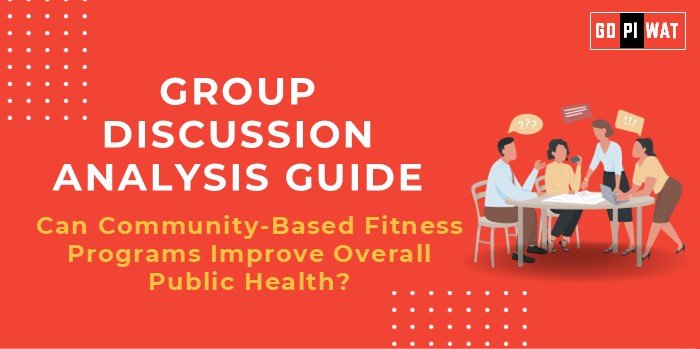📋 Group Discussion (GD) Analysis Guide
🏋️ Can Community-Based Fitness Programs Improve Overall Public Health?
🌐 Introduction to the Topic
Opening Context: Community-based fitness programs offer an inclusive approach to tackling public health challenges like obesity, diabetes, and sedentary lifestyles. These programs are particularly relevant in the context of growing lifestyle diseases globally.
Topic Background: Historically, fitness has been viewed as an individual pursuit, but recent years have seen a shift toward collective efforts. Governments, NGOs, and fitness enthusiasts are now leveraging community spaces and technology to promote health inclusivity.
📊 Quick Facts and Key Statistics
- Global Obesity Prevalence: Over 1 billion people globally are obese (WHO, 2023).
- Physical Inactivity: 1 in 4 adults worldwide fails to meet recommended physical activity levels (WHO).
- India’s Fitness Gap: Over 50% of urban Indians live sedentary lifestyles (India Fit Report 2023).
- Economic Burden: Chronic diseases due to inactivity cost the global economy $54 billion annually (World Bank).
🧑🤝🧑 Stakeholders and Their Roles
- Government Agencies: Provide funding, infrastructure, and policy frameworks for community fitness initiatives.
- Healthcare Providers: Promote fitness programs as preventive healthcare measures.
- Corporates and NGOs: Organize campaigns, offer resources, and sponsor programs.
- Community Members: Actively participate to ensure program success.
🌟 Achievements and Challenges
Achievements:
- Improved Physical Health: A community-based walking initiative in Chennai reduced participants’ BMI by 15% in a year.
- Social Cohesion: Programs like Park Runs in the UK enhance both physical and mental health.
- Cost-Effectiveness: Shared facilities and group sessions reduce individual fitness costs.
Challenges:
- Participation Gaps: Rural areas lack facilities; urban programs often exclude marginalized groups.
- Sustainability Issues: Many programs struggle to sustain due to inconsistent funding.
- Behavioral Barriers: Cultural perceptions and time constraints deter regular participation.
🌍 Global Comparisons:
- Finland’s “Fit Finland” Initiative: A successful model integrating public health campaigns with community sports.
- US Blue Zones Projects: Transform public spaces to encourage walking and social activities.
🗣️ Structured Arguments for Discussion
- Supporting Stance: “Community-based fitness programs provide affordable and scalable solutions for addressing widespread public health issues like diabetes and obesity.”
- Opposing Stance: “Without sustained funding and inclusivity measures, these programs risk limited long-term impact.”
- Balanced Perspective: “While these programs show promise, their success hinges on addressing infrastructure and behavioral challenges.”
💡 Effective Discussion Approaches
- Opening Approaches:
- “Physical inactivity costs the world $54 billion annually.”
- “In Finland, community fitness has reduced cardiovascular diseases by 25%.”
- Counter-Argument Handling: Rebut concerns with examples of successfully scaled programs, like Zumba classes in underprivileged areas of Mumbai.
📈 Strategic Analysis: SWOT
- Strengths: Cost-effectiveness, inclusivity, preventive healthcare benefits.
- Weaknesses: Limited reach, dependence on funding.
- Opportunities: Use of digital tools for wider accessibility.
- Threats: Cultural resistance, potential attrition in participation.
📚 Connecting with B-School Applications
- Real-World Applications: Potential projects on scalable health models for urban and rural communities.
- Sample Interview Questions:
- “How can technology enhance community fitness programs?”
- “What are the economic benefits of reducing chronic diseases through fitness?”
- Insights for B-School Students:
- Analyze fitness trends as a case for preventive healthcare models.
- Study funding strategies for health programs.


